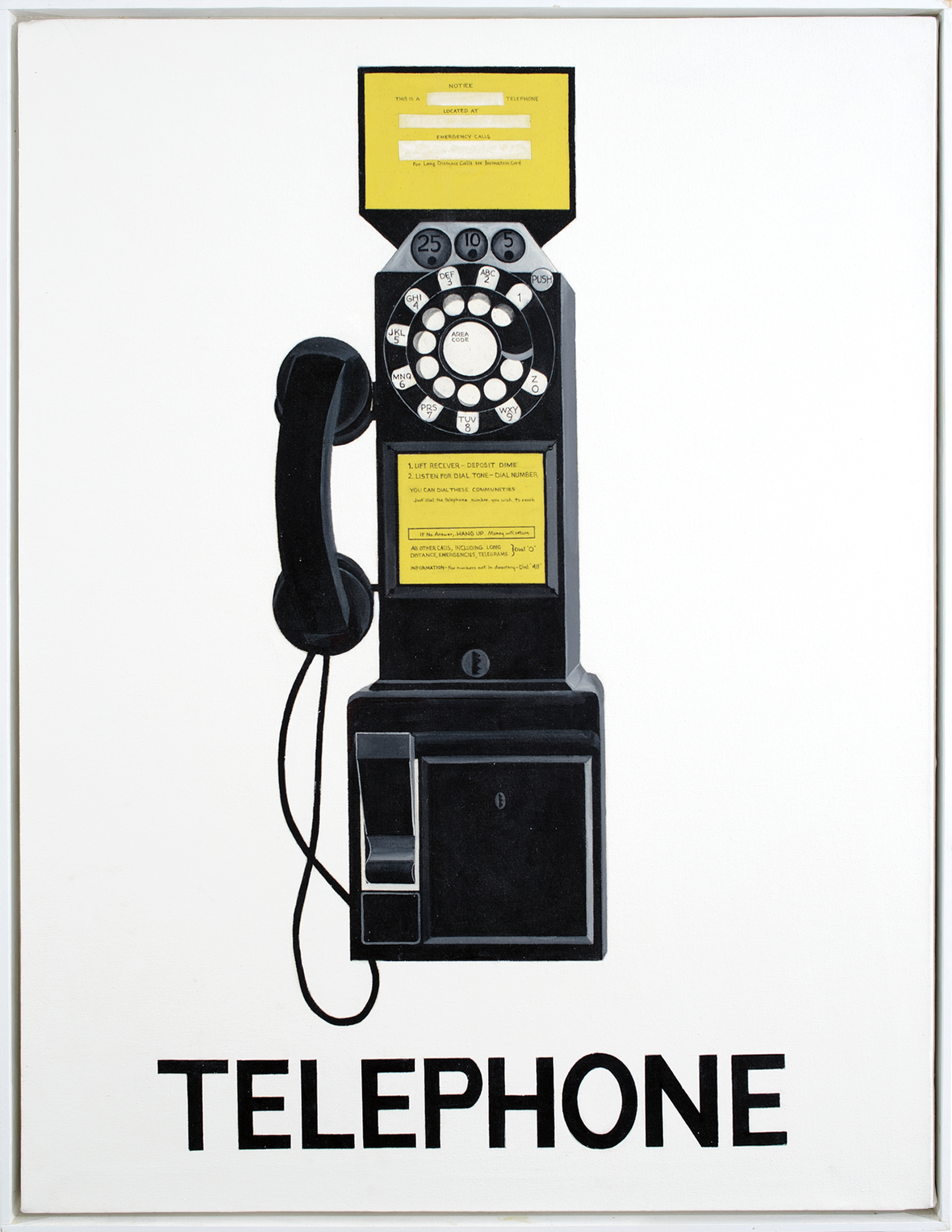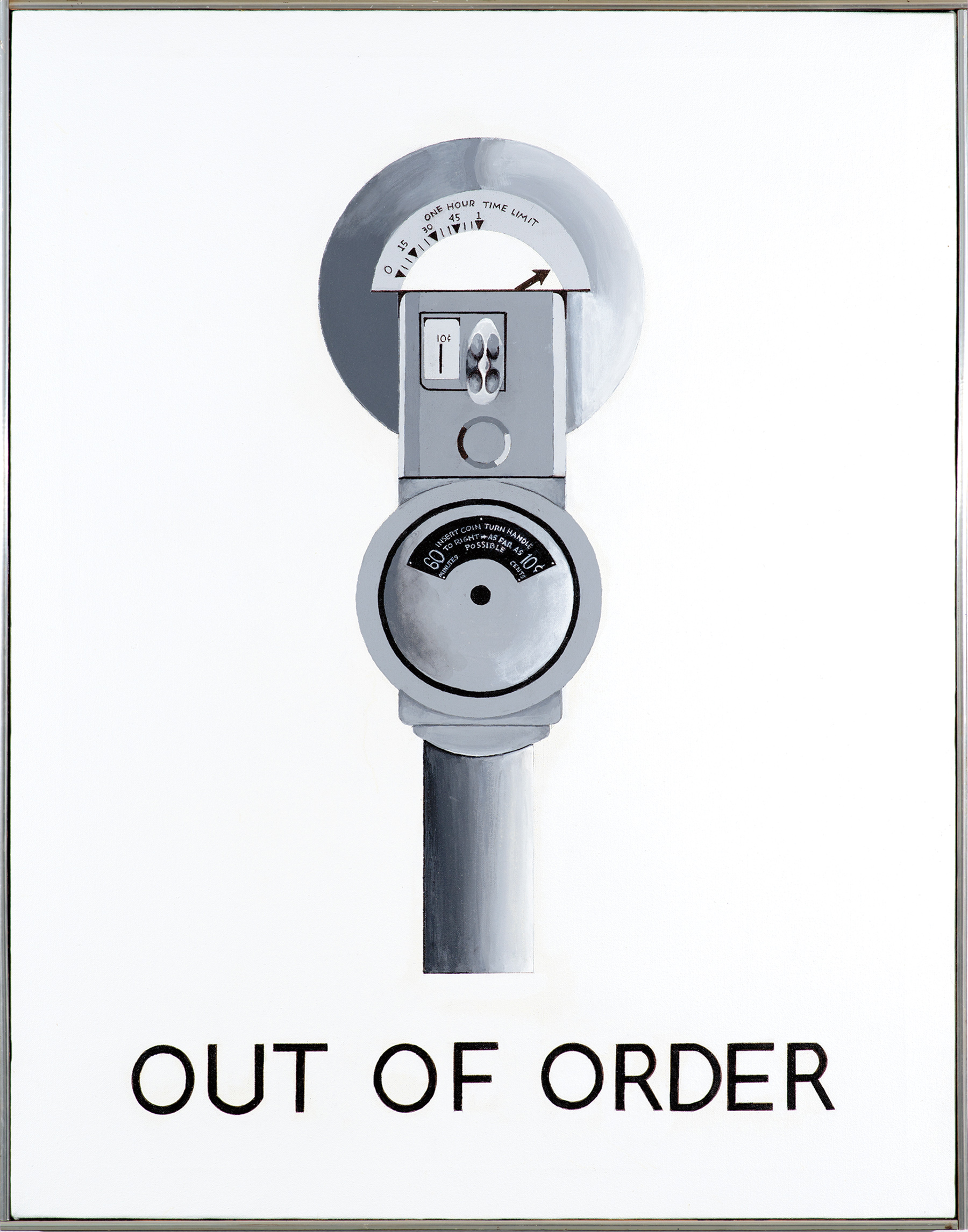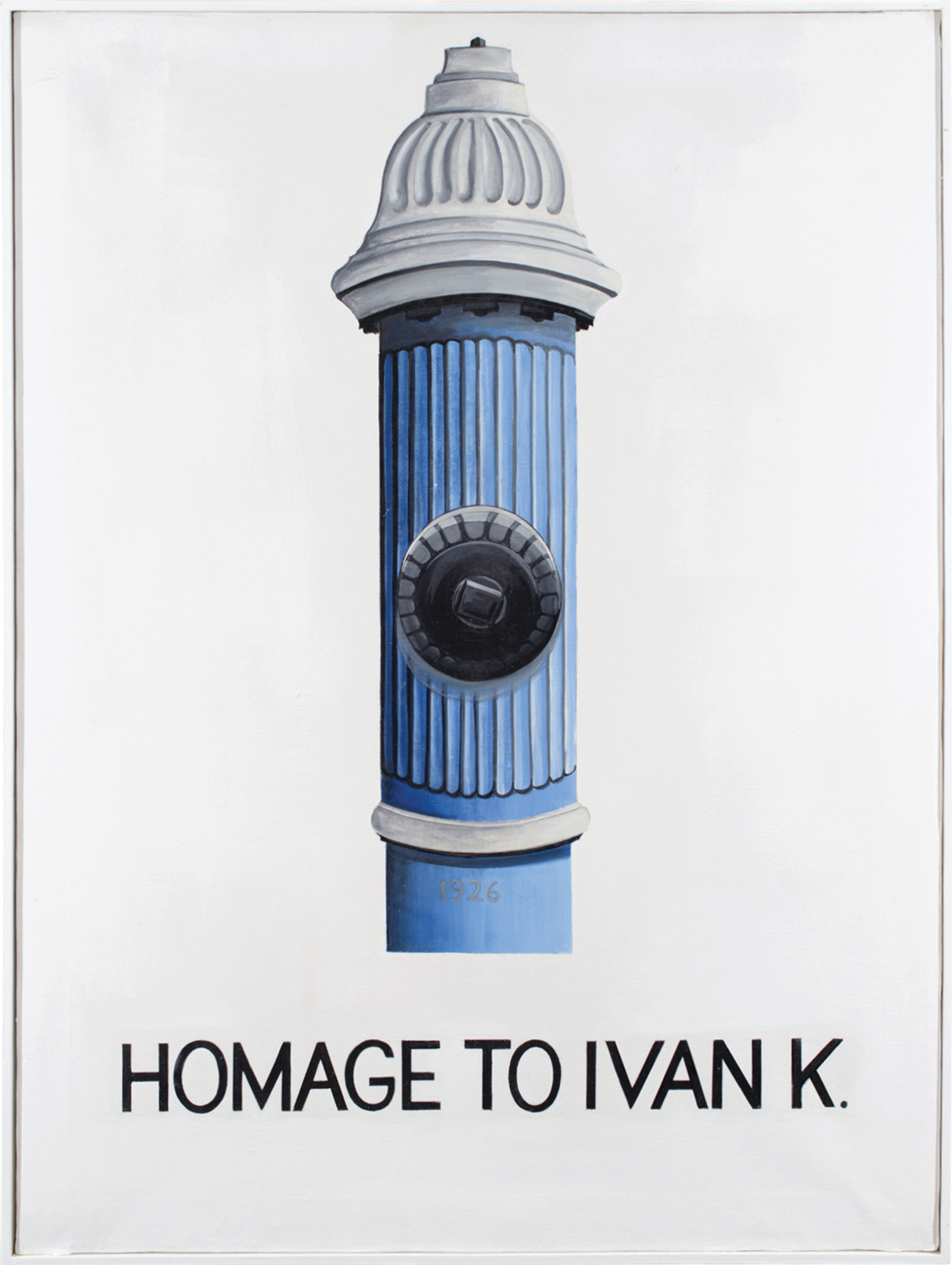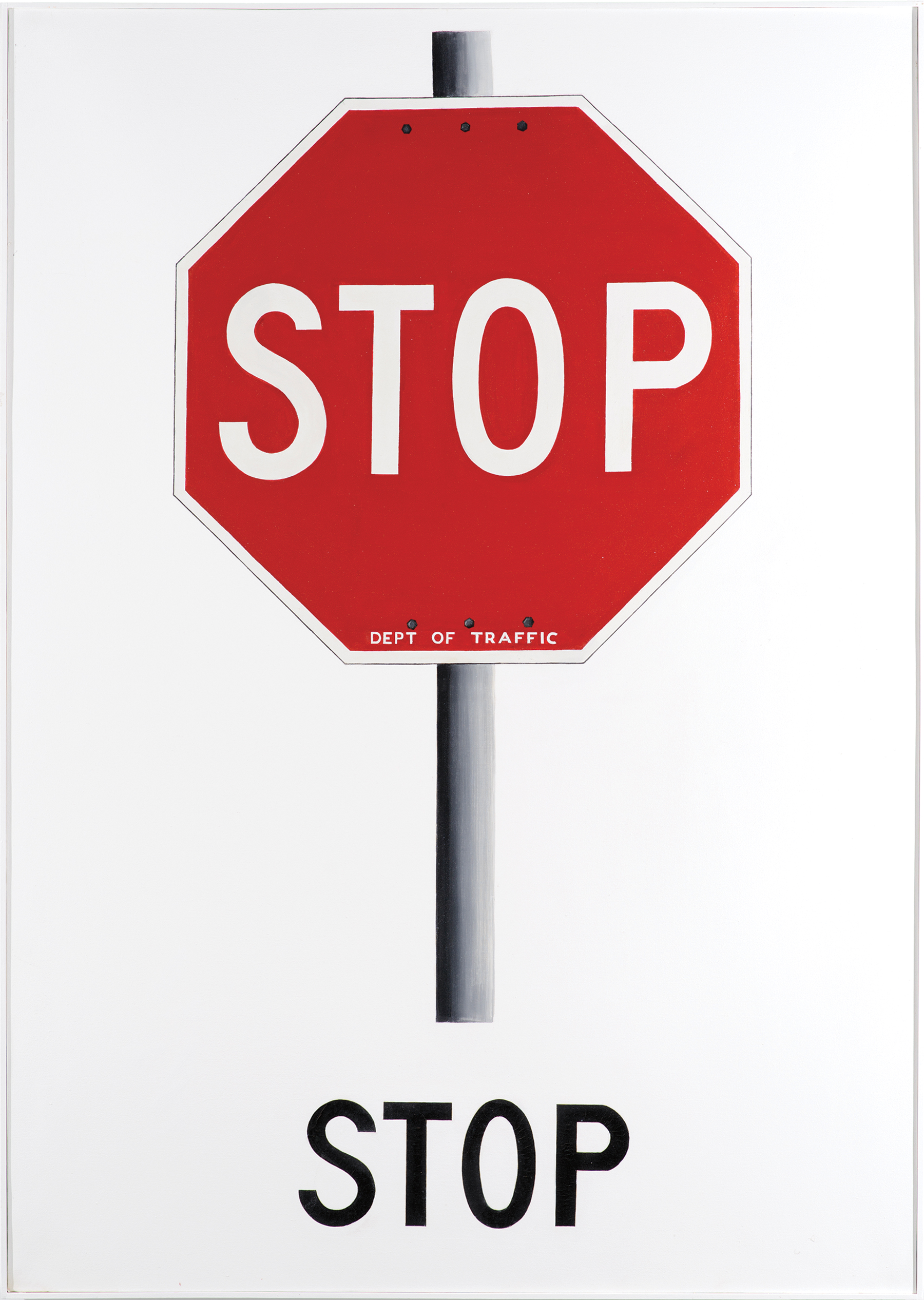Vern Blosum was seemingly there at Pop art’s inception. Not only did Lucy Lippard include the artist’s Telephone (1964) in her seminal book, Pop Art (1966), but Blosum also exhibited in several historically significant exhibitions: John Coplans’s Pop Art USA (1963), the Albright-Knox Gallery’s Mixed Media and Pop Art (1963), and the Washington Gallery of Modern Art’s The Popular Image (1963). Tomwork at Assembly’s exhibition Vern Blosum: Out of Order, Paintings 1962–1964 resuscitates Blosum from obscurity just enough to raise important questions about the artist and his work in relation to issues of authorship and the canonization of Pop in its early years.
Tomwork’s exhibition focuses on thirteen of Blosum’s paintings of the everyday technologies and signage of the modern city. Images of stop signs, parking meters, fire hydrants, and mailboxes combine with hand-painted words beneath each representation that reference the images in various degrees. For example, the painting Telephone (1964) depicts a wall-mounted pay phone with the word “TELEPHONE” below the image. Many of the paintings on display are of parking meters, each with different amounts of time remaining: Fifteen Minutes (1962), Zero Minutes (1962), Giant Expiration (1963). The work is competent, deskilled, and pedestrian—capturing Pop’s baseline aesthetics. The artist is seemingly another American everyman who paints the quotidian aspects postwar life (i.e. Warhol’s Campbell’s Soup cans, Lichtenstein’s comics, Johns’s Flags, etc). Yet, aesthetic critique feels secondary to the exhibition’s value in recovering Blosum from historical anonymity. And Blosum’s competency might have been strategically intentional.

Vern Blosum, Telephone, 1964. Oil on canvas, 46.75 × 35.75 inches. Photo: Greg Wilken. Courtesy of the artist, Assembly, and Tomwork.
What is most important here is the artist’s backstory. “Vern Blosum” is a pseudonym used by an obscure abstract painter intent on exposing the grand farce of what was known then as “New Realism,” “Pop,” and “Common Object Painting.” Blosum’s true identity remains a mystery, known by only a few, but some biographical facts have emerged.1 We know, for example, that he studied painting briefly with Adolph Gottlieb at the University of California, Los Angeles, attended Hunter College’s graduate art program, and created Pop paintings for only three years, 1961–64.
Blosum’s connection to the Abstract Expressionist Adolph Gottlieb is significant in understanding the artist’s work. As a movement, Abstract Expressionism relied on the painterly gesture (the visible brushstroke) as both an actual mark and a symbolic marker of the artist’s heroic presence; the gestural brushstroke was the trace of authorial authenticity (not just its representation) leading directly to the historical figure of the artist. Pop art, including Blosum’s, attempted to puncture these pretensions by insisting on banal representations and the utilitarian mark of the sign painter or the mechanical imperfections of the printing process. Blosum, an Abstract Expressionist by training and practice, armed himself with the anonymity of a pseudonym in order to reveal what he saw as the shallowness of Pop art.

Vern Blosum, Out of Order, 1962. Oil on canvas, 36.25 × 28.60 inches. Photo: Greg Wilken. Courtesy of the artist, Assembly, and Tomwork.
Blosum’s paintings were made to demonstrate the insipid lack of value, skill, and seriousness of an emerging movement the artist wished to derail. As Blosum recently explained: “My reaction to Pop Art was quite intense and quite aggravated…. [T]his form of art was taking over, but I never called it art. And I tried to explain what was happening.”2 It was an odd gamble: if Blosum’s paintings had failed to find a market, they would have failed in the typical way that individual art works are so commonly rejected—atomized and forgotten. But that clearly did not happen. Perhaps Blosum hoped his paintings would be rejected in a more spectacular way, tout court, and in so doing contaminate the whole Pop movement.
In fact, far from being rejected or exposed as too bad even for Pop, Blosum’s work found immediate success. Leo Castelli Gallery represented the artist, and the Museum of Modern Art purchased Time Expired shortly thereafter. Blosum coopted the basic tenets of Pop art too well to fail. As Suzi Gablik explained of Pop’s common characteristics, “[Pop] is simple, direct, and immediately comprehensible. Among American Pop artists, it was relatively easy to find works in which form and iconography fuse in a single, unified image.”3 Blosum not only created such unified images but also focused on the mundane aspects of the modern world. As Gablik identified, “The Pop artist who documents the most ordinary scenes from daily life views the world as a total and inclusive unit in which all parts have total relevance…. Objects are particularized, often isolated rather than juxtaposed, in a non-associative and abstract way which has the effect of converting the familiar into the monumental.”4 It makes sense, then, that Blosum’s fakes were so readily accepted, for his isolated road signs and streetscape technologies, and the style in which he painted them, conformed perfectly to the defining characteristics of the art he wished to counter.

Vern Blosum, Homage to Ivan K, 1963. Oil on canvas, 40 × 30 inches. Photo: Greg Wilken. Courtesy of the artist, Assembly, and Tomwork.
Lucy Lippard’s inclusion of Blosum’s Telephone (1964) in her book further illustrates the artist’s seamless integration in the movement. Lippard sought to document the sheer number and diversity of artists that contributed to the movement’s rise; Sam Goodman, Derek Boshier, Gerald Laing, Nicholas Krushenick, Stephen Durkee, and Vern Blosum were presented alongside the now familiar giants of the genre—Claes Oldenburg, Andy Warhol, James Rosenquist, and Roy Lichtenstein. In Lippard’s estimation, Pop was a capacious style unified by its reversal of Abstract Expressionism’s “emotional and technical impastoes.”5
Blosum’s distaste for Pop can be understood within the larger discourses that emerged in opposition to Pop at its inception. Critics such as Max Kozloff castigated the New Realists for their uncritical cooptation of kitsch commercialism. Sounding like a curmudgeon yelling at bad children to get off his lawn, Kozloff railed against what he believed was the juvenile nature of the art: “The truth is, the art galleries are being invaded by the pin-headed and contemptible style of gum chewers, bobby soxers, and worse, delinquents. Not only can’t I get romantic about this, I see as little reason to find it appealing as I would an hour of rock and roll into which has been inserted a few notes of modern music.”6 Los Angeles critic Jules Langsner similarly bemoaned that the new painting was more conceptual than visual, a far cry from the inherent formalist values found in Abstract Expressionism: “Indeed, it’s not necessary to see the pictures at all in order to embellish psychological and metaphysical notions to one’s heart content. The paintings are made to order for ‘word people.’ They make excellent conversation pieces for dinner parties and graduate courses in esthetics.”7 What the critics shared with Blosum was a common distrust of Pop’s borrowing of subject and style from American popular culture, or what Clement Greenberg labeled as kitsch. As Greenberg wrote, “Kitsch is the epitome of all that is spurious in the life of our times. Kitsch pretends to demand nothing of its customers except their money—not even their time.”8 To Greenberg, kitsch was too easily digestible as either advertisements or propaganda. Kitsch as high art threatened the foundations of a free society, and, as such, oppositions to Pop were fervent.
If Blosum’s practical critique—the making of Pop paintings literally too good (or bad) to be discovered—failed to disturb the movement, his Trojan horse, it turns out, was not to painting, but rather to the museum’s (and art history’s) reliance on the artist’s identity as a guarantor of “authenticity,” the same authenticity at stake in the gestural brushstroke of the Abstract Expressionists. MoMA acquired Time Expired in 1963. A standard collection questionnaire sent to Blosum later that year went unanswered, but it was not until 1965 that MoMA director Alfred Barr was troubled enough to try to get to the bottom of the problem. In a letter to Leo Castelli, Barr stressed the need to straighten out any confusion about the artist’s identity and for the museum to have an accurate record: “Hoax or no hoax, I like the painting which is now on view—but our catalogue is a serious record.”9 In response to Barr’s inquiry, Blosum sent the museum (via Castelli) the following biographical information:
Born in Denver, April 29, 1936
Parents died at early age, moved from relative to relative
First real job was running cars into Mexico for resale
Later became a used car salesman
No formal art training, learned all I know from a friend, who taught me the fundamentals and encouraged me to paint. After five years of intensive work, I moved to South Elgin to be near my friend. My hobbies are flying and reading. I had a plane but lost it when I decided to devote my full time to painting and couldn’t make the payments.10
Remarkably, Blosum’s vague response placated Barr for a bit, and the museum exhibited Time Expired throughout the 1960s. Undoubtedly, Blosum’s veiled biographical information would never have passed for so long without the security of the artist’s Castelli connection. Blosum had Castelli’s provenance, which carried the weight of such canonical artists as Willem de Kooning, Cy Twombly, Robert Rauschenberg, Frank Stella, and Andy Warhol—all of whom, by the way, were comfortably in MoMA’s collection with fully verified bios. By 1973, however, the museum demanded further proof of Blosum’s true identity and, after unsuccessfully attempting to obtain Blosum’s birth certificate, permanently removed his work from view.11 From purchase to removal, the process took ten years.

Vern Blosum, Stop (Department of Traffic), 1964. Oil on canvas, 69 × 48 inches. Photo: Greg Wilken. Courtesy of the artist, Assembly, and Tomwork.
“Hoax or no hoax,” MoMA was obviously more concerned with verification of the artist’s identity than the sincerity of his work. If Blosum had just come forward with his real name, Time Expired might have remained on display. At the same time as the Blosum/MoMA struggle, poststructural theorists sought to fully understand modern culture’s reliance on the author as the focal point of a work’s meaning. As Roland Barthes explained of modern criticism’s elevation of the author (artist) over all else, “the Author is thought to nourish the book, which is to say that he exists before it, thinks, suffers, lives for it, is the same relation to antecedence to his work as a father to his child.”12 Blosum’s refusal to expose his true identity disallowed such artist veneration, disrupting the ability of the museum (and art history) to validate the work’s true value. Even movements like Pop that seemingly challenged the heroic artist-figure of earlier art history still relied on the identifiable personas and styles of its participant artists as determining factors in their success. Warhol is the best example of the paradoxical Pop artist/anti-artist figure. Blosum’s anonymity, once discovered, actively disrupted the requisite veneration of the artist as either a contributor or critic of Pop and, thus, his deaccession from the movement’s history. Ultimately, there is no R. Mutt without Marcel Duchamp.
The parking meter works, with titles like Time Expired, Zero Minutes, Fifteen Minutes, and Out of Order, refer not only to the car as a metonym of modernist progress, in this case stalled and expiring, but also to the artist’s desire for Pop to be finished. His final Pop painting, Stop (Department of Traffic) (1964), was the clearest indicator of the artist’s resignation to this fate. He explained recently, “I didn’t need to go any further. I felt that I had fulfilled all of my predictions…. Some of my friends were achieving success—they were overwhelmed with their success. What the hell does that have to do with painting? I was too much involved with learning my own identity through painting, rather than trying to paint an identity for somebody else to buy.”13
Blosum’s side in this culture war has long surrendered. The question remains as to why he never came forward to expose his grand hoax. Instead, he walked away from the whole mess. We can only imagine what effect might have resulted if Blosum had proclaimed defiantly in response to MoMA’s questions: “Chew on this, you lapdogs of market whim! How does it feel to fall for the most obvious, valueless art of all time?”
Damon Willick is Associate Professor of Modern and Contemporary Art History at Loyola Marymount University and a contributing editor at X-TRA.
